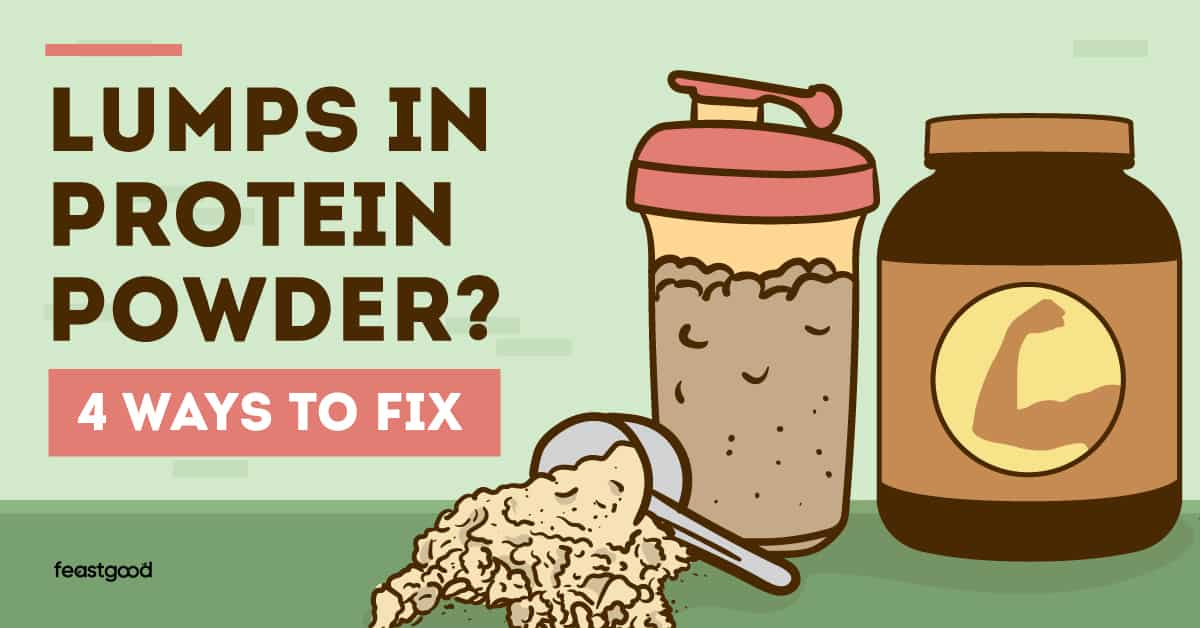Nothing is more frustrating than preparing your protein shake only to discover that it has clumps and doesn’t dissolve properly. To understand how to fix this problem, you first need to know why it happens in the first place.
Key Takeaways
- Because the molecular structure of whey protein includes some fat contents, it can repel water. Although protein is not repellent to water, fat particles repel water and form clumps.
- If you have a lot of clumps, it’s likely due to an improper ratio of protein to water or the water being too cold.
- Protein powders that are lower in quality are more likely to clump than those of higher quality, so look for a protein powder with at least 70% protein per scoop.
6 Reasons Why Does Protein Powder Clump?
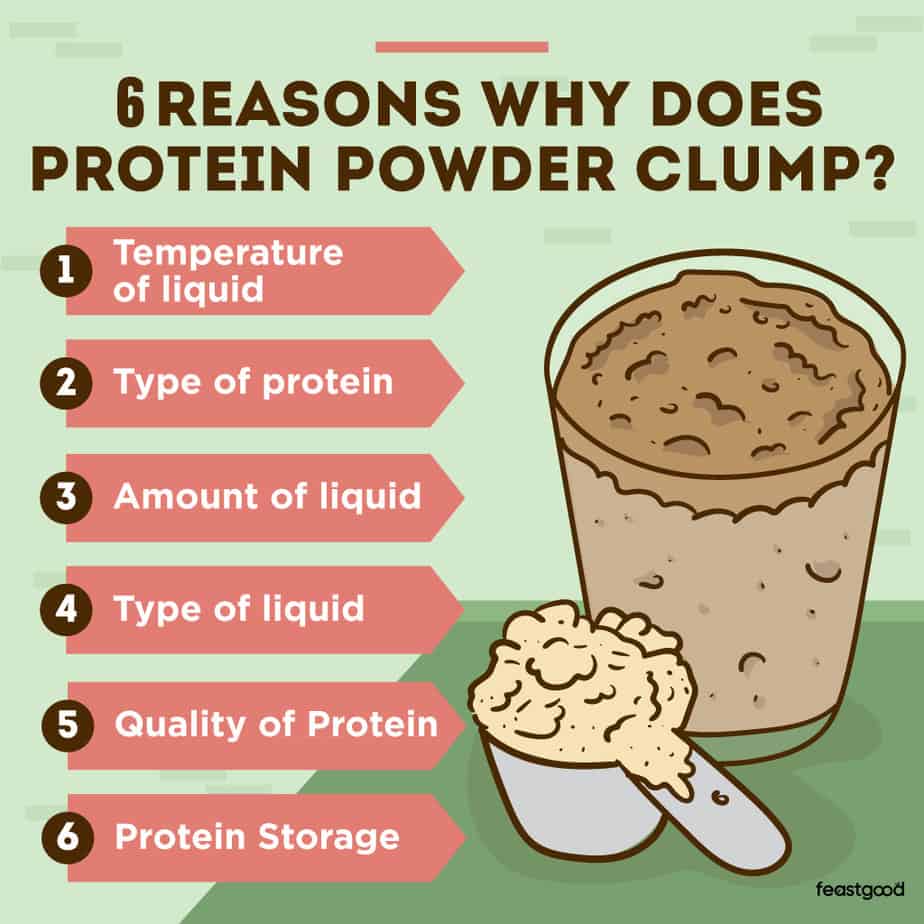
The main reason your protein clumps is because of its molecular form.
Protein and fats both repel water. Fat repels more water than protein, but some protein molecules still repel water.
This prevents the liquid environment (water) from mixing with the solid (protein powder), or at least some of it.
Some other reasons or factors affect if your protein will get lumpy.
1. Temperature of Liquid
The temperature of the liquid affects how well the powder dissolves.
Hot water molecules move faster than cold water molecules. This means the protein molecules collide more with hot water than cold water.
In the end, this increased collision means the powder gets dissolved faster.
2. Type of Protein
There are different types of protein powder: whey and casein. Depending on which protein powder you’re using, it can cause more or less clumping.
Due to casein’s amino acid structure, it can clump more easily than whey protein. This is because it has a higher proline content. Proline is an amino acid that doesn’t like water, so it generally repels it.
Plant-based proteins like peas and rice are much more likely to clump because they are higher in starches and fiber, which tend to coagulate when mixed with liquids.
For this reason, you’ll have to work harder to mix your protein shake with plant-based protein than with dairy-based protein.
- Related Article: Best Fruits For Protein Shakes
3. Amount of Liquid
If there is more powder than liquid, it is harder to dissolve.
This happens because there is not enough space for the powder to mix with the water molecules, making it harder to combine.
However, when there is too much liquid, it might make it harder to mix as well. Adding too much liquid makes it harder for the protein to bind.
Since too little and too much water are not good for clumping, measuring the ratios between liquid and protein (I’ll cover the exact ratios below).
4. Type of Liquid
The type of liquid also affects if the protein shakes clumps.
A liquid with higher viscosity (thickness) makes it harder for the protein molecules to bind. Resulting in more clumpiness.
Liquids with higher viscosity would be something like milk, coconut milk, or orange juice compared with mixing protein with water.
Also, you need to consider other components in the liquid, like fat molecules, which is the case in different types of milk. In this case, it means it is more likely to interact with the protein powder, making it less soluble.
- Related Article: What Can You Mix Whey Protein With?
5. Quality of Protein
The quality of the protein you’re using can also affect whether or not your protein shake has lumps. A lower-quality protein that has cheap fillers and additives is more likely to clump than a higher-quality protein that is free of filler/additives.
An easy way to determine your protein’s quality is to calculate the percentage of protein per scoop. You can do this by taking the grams of protein per scoop and multiplying it by 4, then dividing that number by the number of calories per scoop and multiplying by 100.
For example:
25g of protein scoop X 4 calories/gram = 100 protein calories
100 protein calories / 130 calories per scoop = 0.77 X 100 = 77%
A reasonable protein will have 65-75% protein per scoop, a good protein will have 75-85% per scoop, and a high-quality protein will have 85%+ protein per scoop.
The lower the percentage of protein in your powder, the more likely it is to clump.
6. Protein Storage
How you store your protein could also affect your protein powder’s potential to clump. Your protein powder is more likely to clump if stored in a warm or humid environment.
In addition to clumping, your protein shake is more likely to go bad in a warm or humid environment by causing amino acids to spoil.
“Protein powder that has been exposed to warm temperatures or humid conditions becomes sticky and forms lumps or masses, known as caking.”
– Gavin Van De Walle, MS, RDN, LN
Store your protein tub in a cool, dry place to avoid clumping and keep your protein powder from going bad more quickly.
- Related Article: Can You Freeze Protein Shakes?
How To Mix Protein Powder Without Clumping
Some links in this article are affiliate links, which means we earn from qualifying purchases. Learn more.
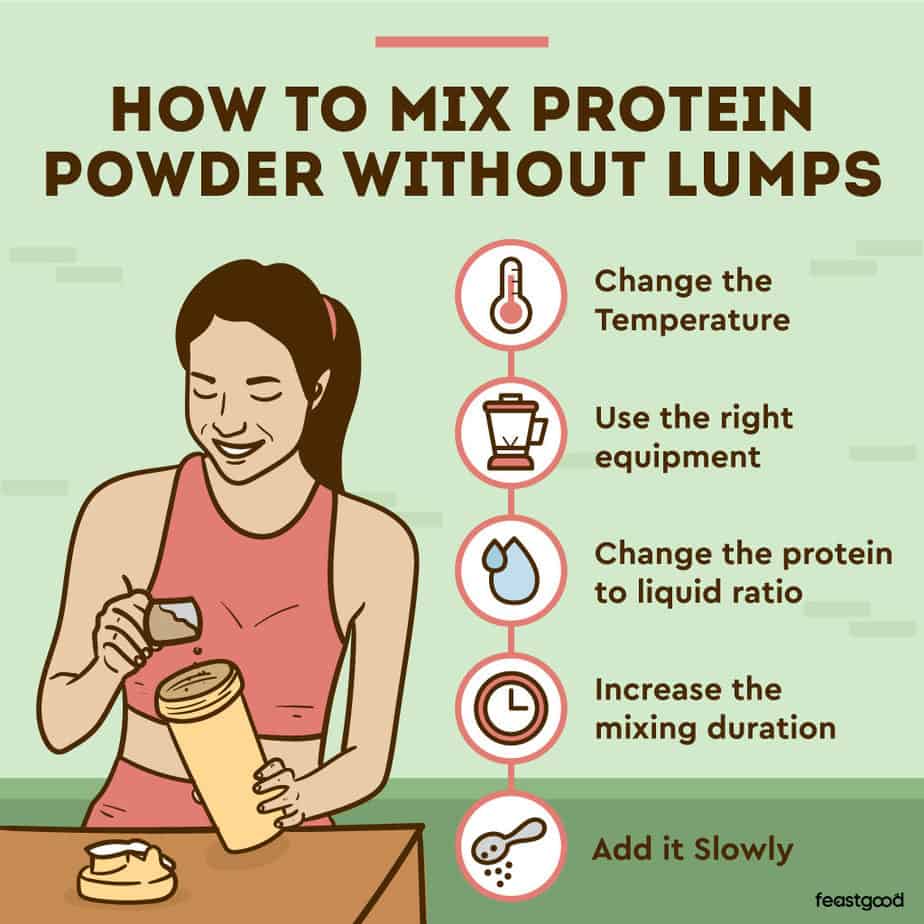
Here are the five best ways to mix protein powder with lumps:
1. Change the Temperature
If you remember your chemistry classes from high school, the temperature tends to speed up chemical reactions. The warmer the liquid, the faster or the more efficiently the powder dissolves.
If you want to increase the solubility (how well it dissolves in water) of the protein powder, try mixing it in a warm liquid (make sure it is warm and not hot).
I know this might not sound appealing when dealing with a protein shake, especially post-workout when you’re already hot and sweaty, but it’s the best way to ensure your protein doesn’t clump.
You can do it two ways:
- The first option is to dissolve it in room-temperature water (or milk). Once the powder is completely dissolved, you can add some ice.
- The other way is to add a warm base—for example, coffee. One of my favorite morning recipes is mixing vanilla (or chocolate) protein powder in my morning coffee.
Related Article: I Left My Protein Shake In The Fridge Overnight (Here’s The Result)
2. Use the Right Equipment
Using the right equipment to mix or stir your shake is fundamental to prevent any clumping.
Over the past few days, I have been using the PROMiXX Pro Shaker Bottle, which I bought from Amazon. It is an innovative portable, electric blender, which you can check out in the following video:
It’s the size and weight of a protein shaker, but it comes with a small electric blender. After some testing, I found no clumps in my protein shakes.
One concern I originally had was that it might create foam at the top of the shake, which I wouldn’t say I like because it can cause bloating or gas due to excess air intake.
However, it didn’t create any foam while mixing, which in my opinion, is better than a regular shaker bottle.
Besides the electric blender, there are several tools that you can use to prevent any lumpy protein shake, including:
(Click the links to be taken to my top recommendations on Amazon)
- Blender. The top option to use is a blender. You just add the ingredients, and it does the rest. Due to speed and force, it prevents any clumps from forming. The downside: it’s not portable.
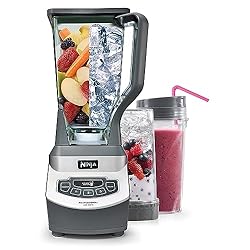
- Shaker. The traditional shaker is another way to go if you take your shake on the go. Shaker bottles come with a lid and a metal ball or grate that help to break up any clumps that form during the mixing process.
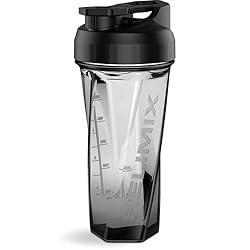
- Cup and fork. Instead of using a spoon to mix the protein shake, try a fork the next time. It works a bit better and prevents any clumpiness.
- Milk frother. This tiny functional equipment can also be taken on the go. If you don’t have the option of having a travel blender, this is another easy solution.
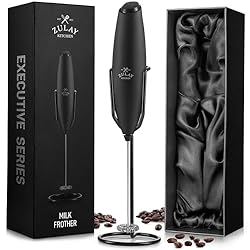
Related Article: How To Mix Protein Powder Without A Shaker or Blender
3. Change the Protein to Liquid Ratio
You might find mixing the protein with less liquid easier than placing the entire liquid in a glass and then mixing the protein shake. Try adding ¼ of the liquid with the protein powder. Once it is mixed, you can add the rest of the liquid.
Pro-tip. Never add the protein powder first and then the liquid. It should be the other way around. First, add the liquid, and then add the protein powder on top.
4. Increase the Mixing Duration
Another way of preventing any clumpiness is by increasing the duration of the mix. Normally, people spend 15-20 seconds mixing the liquid and the protein shake.
However, the longer you manage to mix, the more the lumps tend to break. So, the next time you shake, try to last 45-60 seconds to prevent clumps from forming.
5. Add it Slowly
Instead of adding the entire scoop at once, you can add it slowly. Start by adding 1/3 of the scoop to the liquid.
Once it is all mixed, you can add the next 1/3 until all the protein powder is mixed.
You can also do ½ a scoop instead of 1/3. I find It easier to mix if I have it fractionated more.
What To Do If Your Protein Powder Is Already Lumpy?
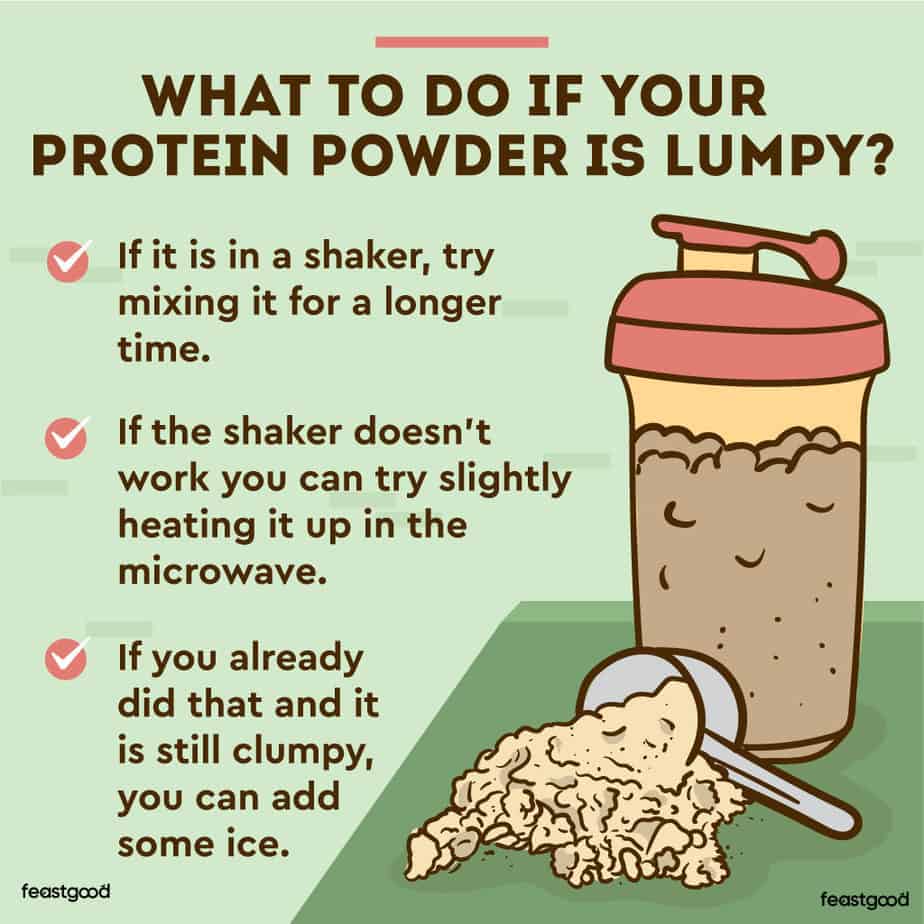
Everything I’ve mentioned above is tips to prevent clumps in your protein shake.
But what if you have already added the protein to the liquid, mixed it, and it is still clumpy?
Here’s what to do:
- Step #1: If it is in a shaker, try mixing it for longer.
- Step #2: If the shaker doesn’t work, you can try slightly heating it in the microwave. Place it for no more than 30 seconds. Protein loses some properties when mixed in boiling water. Thus, mix it in warm water.
- Step #3: If you already did that and it is still clumpy, you can add some ice. Even if it dissolves better in a warm environment, adding ice creates more surface for the protein lumps to break when you shake it.
Is It Okay To Drink Lumpy Protein Powder?
Healthwise and nutritionally speaking, there is nothing wrong with drinking lumpy protein shakes.
However, the experience might not be the best.
Drinking clumpy shakes is not very nice due to the texture, and some might get stuck on your teeth.
This might prevent you from wanting to have the protein shake the next time. If you reduce your protein intake due to this, there is the risk of altering your nutrition goals.
Related Articles:
Are Certain Brands or Types of Protein Better For Not Clumping?
While all protein brands have the risk of clumping, from my experience, these brands will reduce clumpiness by at least 50-60%.
1. Optimum Nutrition Gold Standard Protein (Best Whey Option)
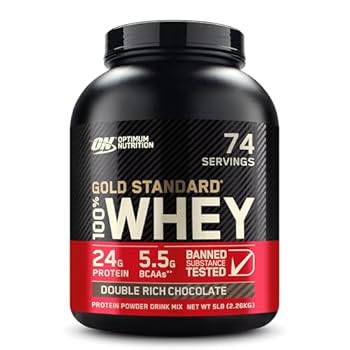
- Check out my complete review of Optimum Nutrition Gold Standard
This protein powder is the best whey option because it has 80% protein per scoop, meaning that it is a higher-quality protein powder that isn’t full of cheap fillers and additives.
My favorite thing about this brand is its wide variety of flavors. Additionally, it has been processed to make the protein “instantized.” This means that the powder is more soluble, preventing any lumps.
2. Orgain Organic Protein (Best Plant-Based Option)
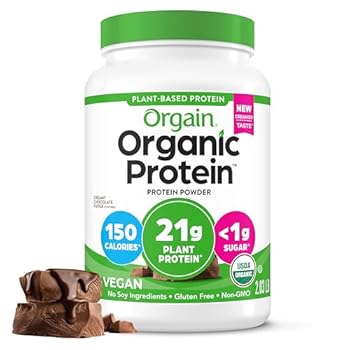
For those who are vegan or vegetarian, this plant-based option is the way to go.
Normally, plant-based proteins clump very easily. This is the one I have found that has less clumping.
It has a blend of plant-based proteins (rice, pea, and chia), ideal for getting different amino acids, making it a complete protein (as if it were animal protein).
But beware, you still might get some clumping with this protein. That’s just the nature of plant-based proteins.
Frequently Asked Questions
Is Clumpy Protein Bad?
Clumpy protein isn’t bad because you will still receive the full benefits of your protein powder, even if it clumps. However, drinking clumpy protein isn’t the most pleasant experience so you probably want to avoid clumps as best you can.
Why Does My Protein Powder Clump In Milk?
Your protein powder is more likely to clump in milk because milk is a cold liquid, and protein powder dissolves more slowly in cold liquids. However, you can avoid clumping by using a higher-quality protein powder and mixing it with a shaker bottle.
Will A Blender Get Rid of The Lumps In My Protein Shake?
A blender is the best way to get rid of the lumps in your protein shake, so if you’re using a lower-quality protein full of cheap fillers, you’ll want to use a blender to make it more enjoyable to drink.
When Should I Add Protein Powder To My Shake To Stop It From Clumping?
To reduce clumping, it’s best to add your protein powder to your liquid rather than adding your liquid to your protein powder.
Reference
Tunick MH, Thomas-Gahring A, Van Hekken DL, Iandola SK, Singh M, Qi PX, Ukuku DO, Mukhopadhyay S, Onwulata CI, Tomasula PM. Physical and chemical changes in whey protein concentrate stored at elevated temperature and humidity. J Dairy Sci. 2016 Mar;99(3):2372-2383. doi: 10.3168/jds.2015-10256. Epub 2016 Jan 6. PMID: 26778305.
About The Author
Why Trust Our Content

On Staff at FeastGood.com, we have Registered Dietitians, coaches with PhDs in Human Nutrition, and internationally ranked athletes who contribute to our editorial process. This includes research, writing, editing, fact-checking, and product testing/reviews. At a bare minimum, all authors must be certified nutrition coaches by either the National Academy of Sports Medicine, International Sport Sciences Association, or Precision Nutrition. Learn more about our team here.
Have a Question?
If you have any questions or feedback about what you’ve read, you can reach out to us at [email protected]. We respond to every email within 1 business day.
